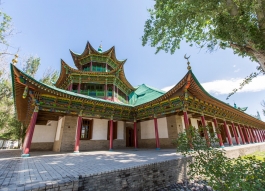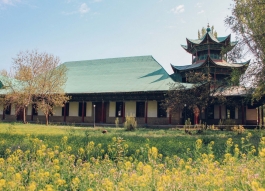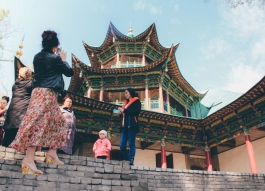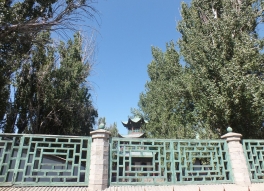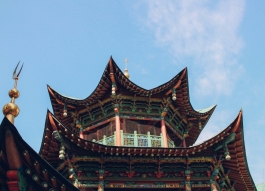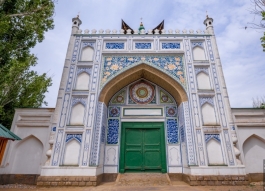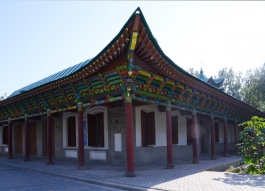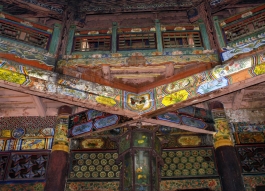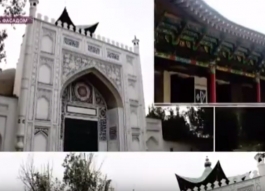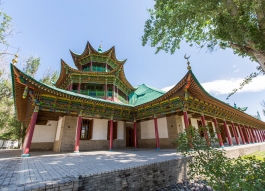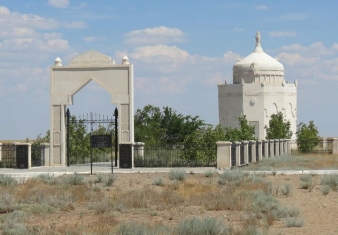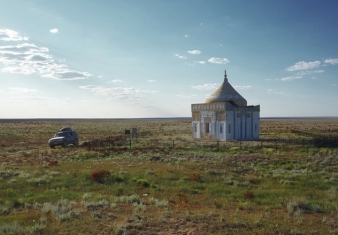 Cultural heritage
Cultural heritage
Architectural and Art Museum in Zharkent mosque is located in the center of Zharkent, Almaty region. The mosque is an architectural monument of the XIX century. It was built in 1895 by the project of Chinese architect - Hong Pique.
Historical background of the museum construction is amazing like an eastern tale. In 1887, at one of the Muslim community meetings, it was decided to collect money for the construction of mosque. The main sponsor and organizer was the first guild merchant Vali Akhun Yuldashev, who also contributed. There were collected over hundreds of masters and builders for construction. Architect Hong Pique led the construction and decoration of the mosque with participation of folk artists as Hassan Imanov, Tahir Ismailov, Nasreddin Kara, Abdukadir, Ushurbak, Zaynutdin and others. They say that Chinese architect accepted the offer of Vali Yoldashev. Master wanted to build a Muslim mosque with Chinese style in his homeland, but local authorities would not let him. Therefore, he decided to realize his dream on the Kazakh land.
According to folk legend, the constructor of the mosque Chinese architect Hong Pique was executed after returning to Beijing, as soon as there was not more beautiful mosque in the Celestial Empire than built mosque in Zharkent. During construction, multilingual of builders completely united their action; gang had translators, who knew Chinese and several Turkic languages. According to what occurred, builders worked with agreement.
According to rumor, Chinese architect first raised a beautiful building in his homeland. People, to whom the building was intended, were was so pleased with construction that they began to fear of architect, who could create something similar on another place. In order not to make it happen, admirers of his talent decided to deprive architect of life. Hong Pique heard about the impending "reward" for his creative approach to assigned work. The only his desire was to leave far away from his jealous fan as soon as possible, and he had no choice to appear in front of zharkents, who were looking for an architect. Later, he returned to his homeland.
There was a stamp of the architect's talent and identity on the whole construction. He creatively used elements of Chinese architecture by giving some features of Buddhist temple to the mosque. A special grace and lightness are given by floating roof, which have curved ends upward the slope. Also, encircling gallery of the building with cylindrical columns is without capitals, large cornice. The main hall can accommodate about thousand worshipers, largely makes a large number of wood carvings and bright polychrome. Due to the surface of arches and walls, it acquires openwork and artistic sophistication. Ornaments have floral motifs, but there are also images of birds, fishes, real and fantastic animals.
The total area of the mosque is 28 × 54 m, height-14.5 m, height of the minaret - 19 m. The minaret was surrounded by 52-columns. Entablature was decorated with wooden carvings. Columns were made of Tien-Shan spruces. Nails did not used during construction of columns and other wooden parts. The walls of the mosque were made of boards, and the roof was made of tin.
The interior was decorated by Arabic script, also used national ornaments. There is a small courtyard in the north-east side of the mosque yard, and on the south - madrassas. Mosque complex is fenced with stone wall, height of which is 2.3 m. There are gates on the southern and northern sides. The mosque was built in the style of architecture in Central Asia.
History of Zharkent mosque survived a lot over 116 years, but it was preserved. There was a powerful earthquake in 1910. Significant damage occurred in the portal of the mosque: two decorative towers were collapsed; the top of the dome was fallen, because cracks formed in the sails of domes. Thus, staircases leading to the roof were closed, and access to the mosque through the main gate was stopped. In 1948 - 1949, a deep study of the mosque was carried out for the first time, after which this outstanding monument was taken under state protection.
There was hurricane wind in Zharkent, 1965. However, well-established construction was preserved from that natural disaster. The building was used as warehouses and granaries through different years. There also lived people, and every year it is increasingly falling into decay.
The first serious study of the mosque was in 1969, and conducted engineering research and studying the features of construction and decoration. During restoration works in 1975-1978, it was decided to create unusual museum - "Zharkent mosque" architectural and art complex.
The Chairman of the Council of Ministers of the Kazakh SSR B. Ashimov signed a decree of the Council of Ministers of the Kazakh SSR about opening the architectural and art museum in Panfilov (Zharkent) on 24 March 1978. There was a partial reconstruction in 2001-2004, during which the roof was updated and tidied the main portal.
Annually, thousands of tourists visit "Zharkent mosque" architectural and art complex, and they admire it.
The curious fact is that a large green tree grows in the courtyard of the museum, and everyone, who touches it, can make a wish, which will certainly come true.
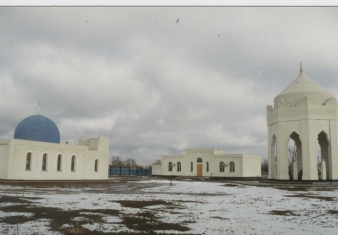
In 50 km from the modern city of Atyrau, there is one of perspective tourist routes, regional memorial estate "Khan Ordaly Sarajshyk" who opens all ancient history of the Kazakh people.
The grave site of the great Kazakh poet of the 19th century, free-thinker and inspirer of the rebellion of Makhambet Utemisov is situated in Inder, Atyrau region, 40 km to the south-east from the village Inderbor.
Atyrau region is rich in its architectural monuments of culture, one of them is considered to be Zhuban Mausoleum.
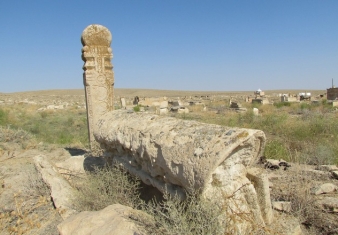
Senek reserve is an architectural monument of the XVII - XX centuries, it represents a necropolis consisting of several sepulchral constructions and an old mosque.
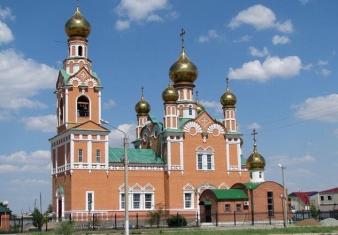
One of the oldest and most beautiful architectural monuments of the city - Uspenski Cathedral is located in the heart of the city of Atyrau, on Issatay Taimanov street, just a few steps from the main square.
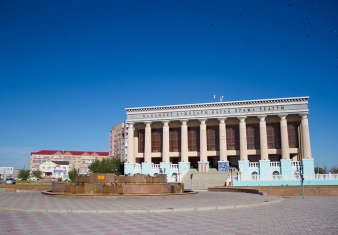
One of the leading places in the cultural life of Atyrau and the whole Atyrau region belongs to the Kazakh Drama Theater named after Makhambet Utemisov.














